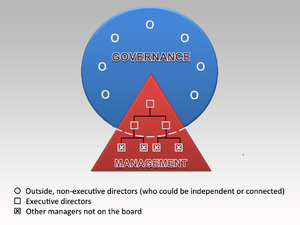I once worked for a young organisation with big ambitions. The managers were all highly experienced, but had only recently come together as a team. They decided to contract with a long-established and very stable international firm to help with operations.
I don’t think anybody was expecting what happened next. The partner firm arrived, and immediately started to call the shots. Needless to say, hackles rose amongst my colleagues – we were the customer, after all: isn’t the customer always right? It took some considerable (and uncomfortable) time to make the relationships work.
What happened? This was all about organisational maturity. The partner organisation had well-established ways of doing things and strong internal relationships. Everyone knew what they were there to do, and how it related to everyone else. They knew that their colleagues could be trusted to do what they expected, and to back them up when necessary. That organisational maturity gave them a high degree of confidence.
My organisation, on the other hand, had none of that. Although individuals (as individuals) were highly competent and confident, there had not been time for strong relationships to develop between us. Although there would be an expectation of support from others, without having been there before certainty about its strength, timeliness and content was lacking. In those circumstances, collective confidence cannot be high. Eventually our differences were sorted out, but it might have been quicker and easier if the relative lack of organisational maturity and its consequences had been recognised at the start.
Confidence comes not just from the confidence of individuals. It is also about the strength of teamwork, and a team has to work together for some time to develop that trust and mutual confidence. When two organisations interact, expect their relative maturities to affect the outcome.
I’ve just been asked by some consultants I’m working with to give feedback for their annual appraisals. As usual there is a standard set of questions they need addressed – and one of them is about leadership. That seems a tough ask for someone junior who has only started recently, and set me thinking about how I could help them. Here’s what I said.
Leadership is different for every individual. Everyone has their own personality, and so everyone has to do it in their own way. Why? It’s very simple.
Leadership means that people are willing to follow you, and for that to happen, two things are necessary: people must trust you, and you must have something to say.
Trust comes when you behave with integrity. Everything you do is consistent, both with your values and with your personality, so people have confidence about outcomes. You are ‘authentic’. Everyone has their own personality, so everyone’s leadership is different. If you try to lead the way someone else does, you are inevitably trying to be consistent with their personality and not with your own. Even if you can do it, you will feel uncomfortable. You will come over as not authentic, and you won’t be fully trusted. As Oscar Wilde said, “Be yourself; everyone else is already taken!”
Leadership is for everyone
Everyone has something to say. We all have unique experiences starting from our earliest days, and it is human nature to use the stories of our past experiences to help us decide how to deal with new situations. Everyone has insights they can contribute, although of course the more experience you have the more you have to offer. If everyone can do these two things, leadership is not just for Leaders with a capital L. Leadership is about having the confidence to be yourself, and to share whatever your experience tells you about the situation you are in. Followers will follow! A few years ago, I was attending a meeting which was a few minutes’ drive from my office. I left a little later than I intended, and although the roads were quiet, when I arrived I had to park further way from my destination than I had expected. The extra walk meant that I arrived at the meeting, which had started promptly, a couple of minutes late.
Naturally, I apologised for my lateness and explained what had happened as I sat down, thinking little of it. It was only two minutes after all. I was completely taken aback when the chair of the meeting replied in an angry voice “Two minutes can cost a life”.
I should explain that he was an ex-military man, and I can understand that being late for a rendez-vous on active service could have very serious consequences. However, not only were no lives going to be lost as a result of my lateness to that meeting; no lives were likely to be lost as a result of anyone there being late to any meeting, ever.
A few years ago, I was attending a meeting which was a few minutes’ drive from my office. I left a little later than I intended, and although the roads were quiet, when I arrived I had to park further way from my destination than I had expected. The extra walk meant that I arrived at the meeting, which had started promptly, a couple of minutes late.
Naturally, I apologised for my lateness and explained what had happened as I sat down, thinking little of it. It was only two minutes after all. I was completely taken aback when the chair of the meeting replied in an angry voice “Two minutes can cost a life”.
I should explain that he was an ex-military man, and I can understand that being late for a rendez-vous on active service could have very serious consequences. However, not only were no lives going to be lost as a result of my lateness to that meeting; no lives were likely to be lost as a result of anyone there being late to any meeting, ever.
Use criticism carefully
I might have been held up by a phone call to an important customer; I might have been resolving an important safety issue; I don’t remember. In business we are always having to balance multiple priorities, and I probably made a priority choice that I felt was in the best interests of the company. So first of all, it is always a good idea to understand the reasons for what has happened before criticising. But just as important is to make the criticism (if there needs to be one) commensurate with the offence and appropriate to the circumstances. Criticising me in a way that might conceivably have been appropriate in the army, but took no account of a completely different context, diminished my respect for the manager and left me feeling angry at his irrationality. As a result, at the very least it reduced the value of my contribution to that meeting, while I fumed; it probably had much longer-term consequences for our wider relationship. Criticism is a dangerous weapon. Used carelessly, the unintended consequences can be serious.
[caption id="" align="alignright" width="300"] English: Terraced house façades, Montague Street See also 1608624 (Photo credit: Wikipedia)[/caption]
I’ll never forget my first serious experience of negotiation.
I was selling my first house, a small, terraced house in a cheap part of the city. I loved it, because it was the first house I had owned, and because I had put a lot of work – and a lot of myself – into it. I had decorated every room; I had refitted the kitchen; I had installed central heating to replace electric storage heaters. I was moving to a new area, where I knew housing was going to be a lot more expensive.
I had received an offer to buy my house from a junior colleague at work. Obviously that made things slightly awkward to start with. But I was unprepared for what happened when he asked if he could visit again, with a family friend.
They duly arrived, and I showed them around. The family friend, an older gentleman, was very appreciative, admiring everything I had done, complimenting me on my workmanship, and so on. And then, at the end of the visit, he pitched me a new price, substantially lower than the offer my colleague had previously made. I was caught off guard. Having refused the new price, I felt I had to respond to his questions, starting with what was the lowest price I would accept? He came back with requests to throw in this and that if they agreed to a higher price, and so on. We eventually agreed a deal – which actually was not such a bad deal from my point of view – but I was left feeling bruised.
Looking back, I have to admire the technique. All the praise, all the efforts to make me feel good first, worked a treat, and there was nothing in the negotiation itself that I could criticise. He did a good job for my colleague. So why did I feel bruised?
The one thing that was missing in the exchange was creating an honest expectation. I had been led to believe that the friend was there to give a second opinion. It was my colleague’s first house purchase, just as it had been mine, so understandably he wanted someone else to endorse his judgement. I had not expected that the friend was there to negotiate on his behalf – after all, an offer had already been made. Perhaps I was a bit naïve, but I was caught unprepared; the negotiation had high financial and emotional value for me, and I had no experience of handling something like that. I felt that I was backed into a corner, and that personal trust had been breached.
So what is the lesson? Don’t just play fair – make sure everyone knows what game you are going to be playing beforehand, especially if personal relationships are involved. Trust is too important, and too hard to rebuild, to risk losing.
English: Terraced house façades, Montague Street See also 1608624 (Photo credit: Wikipedia)[/caption]
I’ll never forget my first serious experience of negotiation.
I was selling my first house, a small, terraced house in a cheap part of the city. I loved it, because it was the first house I had owned, and because I had put a lot of work – and a lot of myself – into it. I had decorated every room; I had refitted the kitchen; I had installed central heating to replace electric storage heaters. I was moving to a new area, where I knew housing was going to be a lot more expensive.
I had received an offer to buy my house from a junior colleague at work. Obviously that made things slightly awkward to start with. But I was unprepared for what happened when he asked if he could visit again, with a family friend.
They duly arrived, and I showed them around. The family friend, an older gentleman, was very appreciative, admiring everything I had done, complimenting me on my workmanship, and so on. And then, at the end of the visit, he pitched me a new price, substantially lower than the offer my colleague had previously made. I was caught off guard. Having refused the new price, I felt I had to respond to his questions, starting with what was the lowest price I would accept? He came back with requests to throw in this and that if they agreed to a higher price, and so on. We eventually agreed a deal – which actually was not such a bad deal from my point of view – but I was left feeling bruised.
Looking back, I have to admire the technique. All the praise, all the efforts to make me feel good first, worked a treat, and there was nothing in the negotiation itself that I could criticise. He did a good job for my colleague. So why did I feel bruised?
The one thing that was missing in the exchange was creating an honest expectation. I had been led to believe that the friend was there to give a second opinion. It was my colleague’s first house purchase, just as it had been mine, so understandably he wanted someone else to endorse his judgement. I had not expected that the friend was there to negotiate on his behalf – after all, an offer had already been made. Perhaps I was a bit naïve, but I was caught unprepared; the negotiation had high financial and emotional value for me, and I had no experience of handling something like that. I felt that I was backed into a corner, and that personal trust had been breached.
So what is the lesson? Don’t just play fair – make sure everyone knows what game you are going to be playing beforehand, especially if personal relationships are involved. Trust is too important, and too hard to rebuild, to risk losing.
 English: Terraced house façades, Montague Street See also 1608624 (Photo credit: Wikipedia)[/caption]
I’ll never forget my first serious experience of negotiation.
I was selling my first house, a small, terraced house in a cheap part of the city. I loved it, because it was the first house I had owned, and because I had put a lot of work – and a lot of myself – into it. I had decorated every room; I had refitted the kitchen; I had installed central heating to replace electric storage heaters. I was moving to a new area, where I knew housing was going to be a lot more expensive.
I had received an offer to buy my house from a junior colleague at work. Obviously that made things slightly awkward to start with. But I was unprepared for what happened when he asked if he could visit again, with a family friend.
They duly arrived, and I showed them around. The family friend, an older gentleman, was very appreciative, admiring everything I had done, complimenting me on my workmanship, and so on. And then, at the end of the visit, he pitched me a new price, substantially lower than the offer my colleague had previously made. I was caught off guard. Having refused the new price, I felt I had to respond to his questions, starting with what was the lowest price I would accept? He came back with requests to throw in this and that if they agreed to a higher price, and so on. We eventually agreed a deal – which actually was not such a bad deal from my point of view – but I was left feeling bruised.
Looking back, I have to admire the technique. All the praise, all the efforts to make me feel good first, worked a treat, and there was nothing in the negotiation itself that I could criticise. He did a good job for my colleague. So why did I feel bruised?
The one thing that was missing in the exchange was creating an honest expectation. I had been led to believe that the friend was there to give a second opinion. It was my colleague’s first house purchase, just as it had been mine, so understandably he wanted someone else to endorse his judgement. I had not expected that the friend was there to negotiate on his behalf – after all, an offer had already been made. Perhaps I was a bit naïve, but I was caught unprepared; the negotiation had high financial and emotional value for me, and I had no experience of handling something like that. I felt that I was backed into a corner, and that personal trust had been breached.
So what is the lesson? Don’t just play fair – make sure everyone knows what game you are going to be playing beforehand, especially if personal relationships are involved. Trust is too important, and too hard to rebuild, to risk losing.
English: Terraced house façades, Montague Street See also 1608624 (Photo credit: Wikipedia)[/caption]
I’ll never forget my first serious experience of negotiation.
I was selling my first house, a small, terraced house in a cheap part of the city. I loved it, because it was the first house I had owned, and because I had put a lot of work – and a lot of myself – into it. I had decorated every room; I had refitted the kitchen; I had installed central heating to replace electric storage heaters. I was moving to a new area, where I knew housing was going to be a lot more expensive.
I had received an offer to buy my house from a junior colleague at work. Obviously that made things slightly awkward to start with. But I was unprepared for what happened when he asked if he could visit again, with a family friend.
They duly arrived, and I showed them around. The family friend, an older gentleman, was very appreciative, admiring everything I had done, complimenting me on my workmanship, and so on. And then, at the end of the visit, he pitched me a new price, substantially lower than the offer my colleague had previously made. I was caught off guard. Having refused the new price, I felt I had to respond to his questions, starting with what was the lowest price I would accept? He came back with requests to throw in this and that if they agreed to a higher price, and so on. We eventually agreed a deal – which actually was not such a bad deal from my point of view – but I was left feeling bruised.
Looking back, I have to admire the technique. All the praise, all the efforts to make me feel good first, worked a treat, and there was nothing in the negotiation itself that I could criticise. He did a good job for my colleague. So why did I feel bruised?
The one thing that was missing in the exchange was creating an honest expectation. I had been led to believe that the friend was there to give a second opinion. It was my colleague’s first house purchase, just as it had been mine, so understandably he wanted someone else to endorse his judgement. I had not expected that the friend was there to negotiate on his behalf – after all, an offer had already been made. Perhaps I was a bit naïve, but I was caught unprepared; the negotiation had high financial and emotional value for me, and I had no experience of handling something like that. I felt that I was backed into a corner, and that personal trust had been breached.
So what is the lesson? Don’t just play fair – make sure everyone knows what game you are going to be playing beforehand, especially if personal relationships are involved. Trust is too important, and too hard to rebuild, to risk losing.  How often have you found yourself having a conversation, and it gradually dawning on you that the person you are talking to thinks the conversation is about something quite different to what you thought? It happens to us all from time to time, and normally it causes at worst mild embarrassment as one of you says, ‘hang on a minute, I thought we were talking about x’ and the other looks bemused. Sometimes though, miscommunication can cause real problems.
How often have you found yourself having a conversation, and it gradually dawning on you that the person you are talking to thinks the conversation is about something quite different to what you thought? It happens to us all from time to time, and normally it causes at worst mild embarrassment as one of you says, ‘hang on a minute, I thought we were talking about x’ and the other looks bemused. Sometimes though, miscommunication can cause real problems.
E-mail Fireworks
Perhaps the most common place for miscommunication to cause problems in the working world is in e-mails. Maybe the relationship is a bit sticky already, or perhaps the subject is emotive. You write an e-mail, for example telling someone what you are going to do. Writing the message down gives you a chance to choose the words carefully so that they can’t be misinterpreted, right? Wrong! Within a few microseconds of pressing the ”send” button, you notice that your computer has started to smoke from the heat in the reply that has just clanged into your inbox. You read it – how could they have misunderstood your intentions so wildly? They must be spoiling for a fight! Your emotion finds its way into your reply, and the exchange just escalates. E-mail fireworks are never productive. Why are e-mails so fraught? Mainly, they are too easy. We dash them off with little thought. For straightforward factual messages that is not a problem. The trouble comes when the exchange has some (often unexpected) emotional content. Although they seem like a way of keeping the emotion out and so appear to be an easy option, humans are emotional creatures: we don’t often do purely rational. Be especially careful when you are worried about the reaction, and it feels safer to keep your distance. By omitting the emotional context of the message, which we detect mostly from body language and tone of voice, we take away the very cues which would help the recipient to know whether we meant to be provocative or were just not choosing our words very well. Poorly-chosen words in the context of a friendly tone and an open expression will usually only prompt clarification, but without these, people usually assume the worst. Here are five tips for minimising the risk of e-mail fireworks, and getting things back on track if necessary:- If you think the message might have some emotional content, don’t rely on e-mail if you can possibly avoid it. Start the exchange face-to-face, or at least with a phone call, so that there is an emotional context. Only once the tone has been set should you follow it up with an email.
- If you didn’t think the message was emotional, but the response appears to be – or even just indicates misunderstanding - never send an email reply. Pick up the phone straight away to clarify, or go and see them if you can.
- If you have to send an email which you know may be emotive, save a draft overnight before sending it, and re-read it in the morning. You have a better chance then of seeing how someone else might mis-interpret your words, and stopping it before it is too late. I rarely find I change nothing the next day!
- For really sensitive messages which you have to put in writing, ask someone else to check your words before you send them.
- If an exchange has gone emotional, apologise face to face – even if you don’t think you have anything to apologise for.
[caption id="" align="alignright" width="300"] English: Corporate Governance (Photo credit: Wikipedia)[/caption]
All organisations have to find an appropriate balance between central control and local freedom to act. Governance provides the framework and checks and balances within which this is established and managed. It ensures that the process by which decisions are made is appropriately managed. It allows them to be seen to have been taken in the best interests of the shareholders, taking account of all the demands on the organisation, the risks, and the information available at the time.
English: Corporate Governance (Photo credit: Wikipedia)[/caption]
All organisations have to find an appropriate balance between central control and local freedom to act. Governance provides the framework and checks and balances within which this is established and managed. It ensures that the process by which decisions are made is appropriately managed. It allows them to be seen to have been taken in the best interests of the shareholders, taking account of all the demands on the organisation, the risks, and the information available at the time.
 English: Corporate Governance (Photo credit: Wikipedia)[/caption]
All organisations have to find an appropriate balance between central control and local freedom to act. Governance provides the framework and checks and balances within which this is established and managed. It ensures that the process by which decisions are made is appropriately managed. It allows them to be seen to have been taken in the best interests of the shareholders, taking account of all the demands on the organisation, the risks, and the information available at the time.
English: Corporate Governance (Photo credit: Wikipedia)[/caption]
All organisations have to find an appropriate balance between central control and local freedom to act. Governance provides the framework and checks and balances within which this is established and managed. It ensures that the process by which decisions are made is appropriately managed. It allows them to be seen to have been taken in the best interests of the shareholders, taking account of all the demands on the organisation, the risks, and the information available at the time.
Review your governance
If several of the following statements are true of your organisation, it may well be a good idea to review your governance arrangements.- The governance structure (meetings and delegations) does not constitute a simple hierarchy underneath the Board, with clear parent-child relationships and information cascaded up and down the hierarchy
- The governance structure is not clearly documented (e.g. including a consistent set of Terms of Reference), communicated and understood
- People do not have clear written instructions as to the limits of the authority that they have been given, or these are ignored
- Committees are allowed to approve their own Terms of Reference and/or memberships
- Governance meetings happen irregularly, or with papers which are poor quality or issued late
- Senior staff are allowed to ignore the rules which apply to others
- Decisions are often taken late because of papers missing submission dates, inadequate information, wrong attendance, submission to the wrong meeting, unexpected need for escalation, etc
- There is a feeling that the governance process is too bureaucratic
 I’m on my way to a Board meeting. My job as a Board member is to turn up about once a month for a meeting lasting normally no more than a couple of hours to take the most important decisions the company needs – decisions which are often about complex areas, fraught with operational, commercial, legal and possibly political implications, and often with ambitious managers or other vested interests arguing strongly (but not necessarily objectively) for their preferred outcome. Few of the decisions are black and white, but most carry significant risk for the organisation. Good outcomes rely on informing Board members effectively.
This is a well-managed organisation, so I have received the papers for the meeting a week in advance, but I have had no chance to seek clarification of anything which is unclear, or to ask for further information. In many organisations, the papers may arrive late, or they may have been poorly written so that the story they tell is incomplete or hard to understand (despite often being very detailed), or both. The Board meeting, with a packed agenda and a timetable to keep to, is my only chance to fill the gaps.
I have years of experience to draw on, but experience can only take me so far. Will I miss an assumption that ought to be challenged, or a risk arising from something I am not familiar with? If that happens, we may make a poor decision, and I will share the responsibility. In some cases – for instance a safety issue - that might have serious consequences for other people. It’s not a happy thought.
I’m on my way to a Board meeting. My job as a Board member is to turn up about once a month for a meeting lasting normally no more than a couple of hours to take the most important decisions the company needs – decisions which are often about complex areas, fraught with operational, commercial, legal and possibly political implications, and often with ambitious managers or other vested interests arguing strongly (but not necessarily objectively) for their preferred outcome. Few of the decisions are black and white, but most carry significant risk for the organisation. Good outcomes rely on informing Board members effectively.
This is a well-managed organisation, so I have received the papers for the meeting a week in advance, but I have had no chance to seek clarification of anything which is unclear, or to ask for further information. In many organisations, the papers may arrive late, or they may have been poorly written so that the story they tell is incomplete or hard to understand (despite often being very detailed), or both. The Board meeting, with a packed agenda and a timetable to keep to, is my only chance to fill the gaps.
I have years of experience to draw on, but experience can only take me so far. Will I miss an assumption that ought to be challenged, or a risk arising from something I am not familiar with? If that happens, we may make a poor decision, and I will share the responsibility. In some cases – for instance a safety issue - that might have serious consequences for other people. It’s not a happy thought.


 Many years ago, I was given a piece of advice by a sales manager colleague which has stuck with me ever since: “God gave you two ears and one mouth. Use them in those proportions!”
This is not just about sales in the formal sense. Whenever we are trying to influence people for any kind of outcome – and let’s face it, that is most of the time – we should remember it.
Where does influence come from? To gain influence, first we need to be trusted. People need to believe that we are behaving with integrity, that we have their interests in mind, not just our own. Naturally it is best if that is actually true. Second, we need to be respected (in fact, ‘respect for’ is almost shorthand for ‘willing to be influenced by’). Much of respect comes from a perception that we speak with authority, which presupposes trust in what we say.
How do we establish trust? That is where the ears come in. Sadly, the experience of many people in many organisations is that managers never find the time to listen to them properly. Even if you are sitting in front of him or her, it may be clear that the manager’s mind is only half on the conversation you are trying to have. How can you know what matters to someone if you don’t listen when they tell you? If you don’t know, how can you be trusted to look after them? Those ears are very powerful!
As a change manager, listening is a particularly powerful tool. It is a truism that most people dislike change, but I believe that much of that is about feeling they have no voice in it. Even when people come into a meeting feeling angry about a change that is being imposed on them, it always amazes me how much more acceptance can be achieved simply by spending time really listening to them tell you what they don’t like – even if you can’t alter it. Good listening involves the mouth as well: how do they know you heard them if you don’t play it back?
Once you have listened and built some trust, you are in a position to build respect too: by explaining the changes in a way that relates to their concerns but is anchored in reason. They will still need to move through the change curve, but by using your ears and your mouth in the right ways and the right proportions you can make that easier for everyone.
Many years ago, I was given a piece of advice by a sales manager colleague which has stuck with me ever since: “God gave you two ears and one mouth. Use them in those proportions!”
This is not just about sales in the formal sense. Whenever we are trying to influence people for any kind of outcome – and let’s face it, that is most of the time – we should remember it.
Where does influence come from? To gain influence, first we need to be trusted. People need to believe that we are behaving with integrity, that we have their interests in mind, not just our own. Naturally it is best if that is actually true. Second, we need to be respected (in fact, ‘respect for’ is almost shorthand for ‘willing to be influenced by’). Much of respect comes from a perception that we speak with authority, which presupposes trust in what we say.
How do we establish trust? That is where the ears come in. Sadly, the experience of many people in many organisations is that managers never find the time to listen to them properly. Even if you are sitting in front of him or her, it may be clear that the manager’s mind is only half on the conversation you are trying to have. How can you know what matters to someone if you don’t listen when they tell you? If you don’t know, how can you be trusted to look after them? Those ears are very powerful!
As a change manager, listening is a particularly powerful tool. It is a truism that most people dislike change, but I believe that much of that is about feeling they have no voice in it. Even when people come into a meeting feeling angry about a change that is being imposed on them, it always amazes me how much more acceptance can be achieved simply by spending time really listening to them tell you what they don’t like – even if you can’t alter it. Good listening involves the mouth as well: how do they know you heard them if you don’t play it back?
Once you have listened and built some trust, you are in a position to build respect too: by explaining the changes in a way that relates to their concerns but is anchored in reason. They will still need to move through the change curve, but by using your ears and your mouth in the right ways and the right proportions you can make that easier for everyone. 